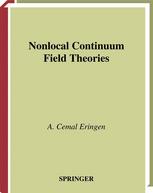

Most ebook files are in PDF format, so you can easily read them using various software such as Foxit Reader or directly on the Google Chrome browser.
Some ebook files are released by publishers in other formats such as .awz, .mobi, .epub, .fb2, etc. You may need to install specific software to read these formats on mobile/PC, such as Calibre.
Please read the tutorial at this link: https://ebookbell.com/faq
We offer FREE conversion to the popular formats you request; however, this may take some time. Therefore, right after payment, please email us, and we will try to provide the service as quickly as possible.
For some exceptional file formats or broken links (if any), please refrain from opening any disputes. Instead, email us first, and we will try to assist within a maximum of 6 hours.
EbookBell Team

5.0
80 reviewsNonlocal continuum field theories are concerned with material bodies whose behavior at any interior point depends on the state of all other points in the body -- rather than only on an effective field resulting from these points -- in addition to its own state and the state of some calculable external field. Nonlocal field theory extends classical field theory by describing the responses of points within the medium by functionals rather than functions (the "constitutive relations" of classical field theory). Such considerations are already well known in solid-state physics, where the nonlocal interactions between the atoms are prevalent in determining the properties of the material. The tools developed for crystalline materials, however, do not lend themselves to analyzing amorphous materials, or materials in which imperfections are a major part of the structure. Nonlocal continuum theories, by contrast, can describe these materials faithfully at scales down to the lattice parameter. This book presents a unified approach to field theories for elastic solids, viscous fluids, and heat-conducting electromagnetic solids and fluids that include nonlocal effects in both space and time (memory effects). The solutions to the field equations agree remarkably well with atomic theories and experimental observations.